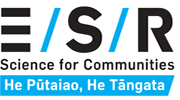|
We welcome the use of this surveillance data with the following acknowledgement, New Zealand surveillance data provided by ESR, funded by the Ministry of Health with the cooperation of the diagnostic laboratories. |
The last five years of data is available here. Shingella isolates data from 2017 - 2004 can be found in the Archive.
-
2021
The year 2021 was unprecedented in that only three cases of shigellosis were confirmed in NZ this year.
This highlights that the vast majority (if not all) Shigellae isolated in NZ are imported: - Our borders closed mid-2020 in response to the COVID-19 pandemic response (shigellosis case numbers dwindled in the latter half of that year) and remained closed for the entirety of 2021.
-
2020
The year 2020 has been unusual at best for everyone and the enteric data for 2020 will always stand apart from other years due the multiple effects of our COVID 19 response on our national data.
When NZ locked down at the end of March 2020, diagnostic laboratories staff and resources were given over to the task of establishing and performing testing for COVID 19. Therefore, diagnostic laboratories were actively discouraging referral of other, more routine work. This coupled with people staying home in small bubbles; not eating out; and not being able to readily access face-to-face medical assistance meant that for a period of two months there were very few enteric pathogens received at ESR for typing.
Once NZ moved back to Alert Level 2, enteric testing and isolate referral gradually recommenced. However, with our borders remaining closed for the remainder of the year we have seen an ongoing reduction in Shigella case numbers compared with previous years. Given all of the above the low numbers noted for the year suggest that Shigella infection is more associated with overseas travel than previously thought – just 12 isolates were received between June and December 2020 compared with 97 isolates for the same time period in 2019.
-
2019
The majority of Shigella isolates were typed using phenotypic methods but four also underwent whole genome sequencing to assist in identification. One of these was then reported as Shigella boydii, one as Shigella species and two as Shigella dysenteriae.
These Shigella dysenteriae were evaluated in comparison with previous NZ isolates and four isolates from 2018 and 2019 were subsequently confirmed as Shigella dysenteriae serotype E112707/96 ST148. This type has been associated with travel to Central Asia and Africa and typically exhibits increased antimicrobial resistance [Terry et al., Journal of Medical Microbiology DOI 10.1099/jmm.0.000779 Antimicrobial resistance profiles of Shigella dysenteriae isolated from travellers returning to the UK, 2004–2017].
The antimicrobial susceptibility of these 2019 Shigella isolates is reported here.
-
2018
Shigella sonnei biotype g remains the most common type confirmed in NZ. Overseas travel to a wide range of destinations was noted as having occurred during the incubation period for 59% of cases.
-
2017
Shigella referral numbers have again increased this year with isolates confirmed from 239 cases compared with 156 in 2016, and 112 in 2015.
Shigella sonnei biotype g remains the most common NZ type, with the emergence of Shigella flexneri 6 Boyd 88 and Shigella flexneri 1b pushing our historically most common type - Shigella sonnei biotype a - to fourth most common for the year. We note that a travel history which includes Tonga appears associated with Shigella flexneri 1b.
